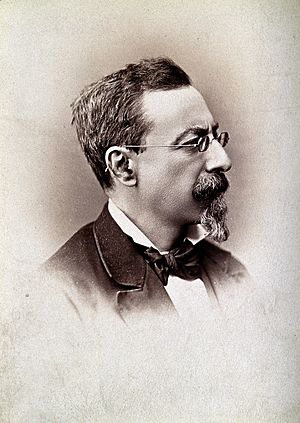Alfonso L. Herrera facts for kids
Quick facts for kids
Alfonso L. Herrera
|
|
|---|---|
 |
|
| Born | June 3, 1868 |
| Died | September 17, 1942 (aged 74) Mexico City
|
| Nationality | Mexican |
| Scientific career | |
| Fields | Biology |
Alfonso Luis Herrera (1868–1942) was a famous Mexican biologist, writer, and teacher. He also helped start several important places in Mexico City. He spent a lot of time researching how life began. He even tried to create a new science called plasmogeny, which focused on making life in a lab.
Contents
About Alfonso Herrera
Alfonso Herrera was born in Mexico City in 1868. His father was a well-known naturalist, someone who studies nature. Alfonso studied pharmacy at the National School of Medicine. He finished his studies in 1889.
Even before he graduated, he had already written several papers. These papers were about animals and birds. After school, he became a teacher. He taught at the National Preparatory School. He also taught at the Military School and the "Normal School for Teachers."
Herrera helped create some important places in Mexico City. He helped start the Botanical Garden of Chapultepec Park in 1922. He also helped create the Mexico City Zoo in 1923. Today, this zoo is still very popular. He also helped found the Biological Institute of the University of Mexico. Alfonso Herrera passed away in Mexico City in 1942.
Herrera's Big Ideas: Plasmogeny
Alfonso Herrera developed an experimental science called plasmogeny. This science was all about understanding how protoplasm began. Protoplasm is the basic living material found in all animals and plants.
Herrera believed that life started from simple physical and chemical reactions. Because of this, he thought it might be possible to create something like living material in a laboratory. He wanted to make structures that acted like natural protoplasm.
To do this, he did many experiments. He tried to create artificial cells, which he called "protocells." He used common substances for his experiments. These included olive oil, sodium hydroxide, gasoline, and other chemicals.
Books and Writings
Alfonso Herrera wrote many books to share his ideas. In 1897, he published Recueil des lois de la biologie générale. This means "Collection of the General Laws of Biology."
Another important book was Nociones de biología from 1904. It was later reprinted in 1924 as Biología y plasmogenia, or "Biology and Plasmogeny." He explained his ideas about plasmogeny even more in Una nueva ciencia – la plasmogenia ("A New Science – Plasmogeny") in 1924. A shorter version came out in 1932, called La plasmogenia – nueva ciencia del origen de la vida ("Plasmogeny – The New Science of the Origin of Life").
He also started two scientific journals. He published his experiments in these journals. One was called Gaceta de Plasmogenia (in Spanish). The other was Bulletin du Laboratoire de Plasmogenie (in French). Many of his books have now been translated into English.
Animals Named After Him
Some animals have been named in honor of Alfonso Herrera. These are called eponyms. Three reptiles are named after him:
- Kinosternon herrerai, which is known as Herrera's mud turtle.
- Barisia herrerae, also called Herrera's alligator lizard.
- Lampropeltis zonata herrerae, which is the Todos Santos Island kingsnake.
See also
 In Spanish: Alfonso Luis Herrera para niños
In Spanish: Alfonso Luis Herrera para niños
- Sulphobes

